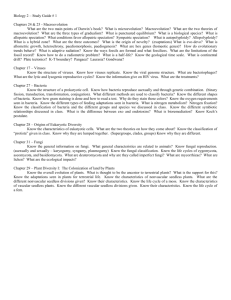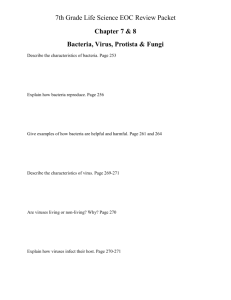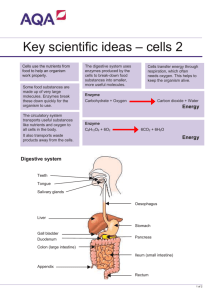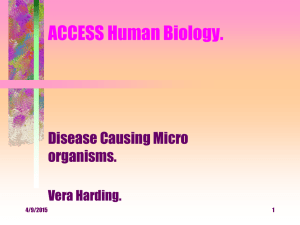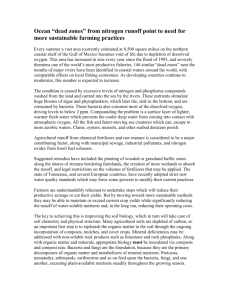53KB - NZQA
advertisement
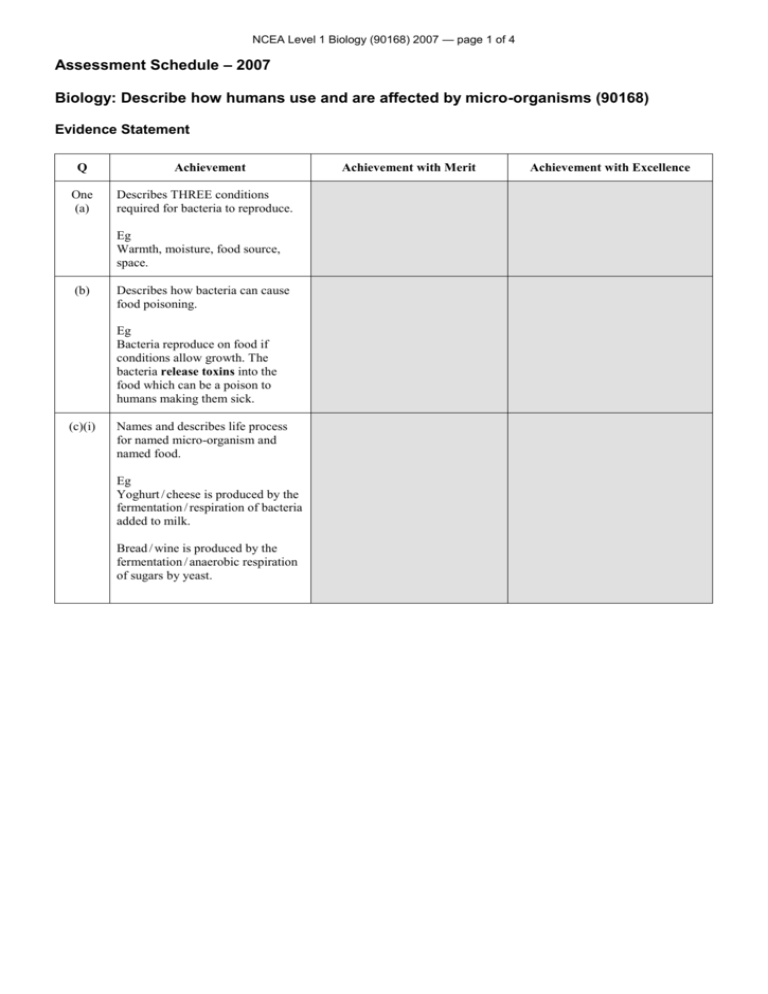
NCEA Level 1 Biology (90168) 2007 — page 1 of 4 Assessment Schedule – 2007 Biology: Describe how humans use and are affected by micro-organisms (90168) Evidence Statement Q One (a) Achievement Describes THREE conditions required for bacteria to reproduce. Eg Warmth, moisture, food source, space. (b) Describes how bacteria can cause food poisoning. Eg Bacteria reproduce on food if conditions allow growth. The bacteria release toxins into the food which can be a poison to humans making them sick. (c)(i) Names and describes life process for named micro-organism and named food. Eg Yoghurt / cheese is produced by the fermentation / respiration of bacteria added to milk. Bread / wine is produced by the fermentation / anaerobic respiration of sugars by yeast. Achievement with Merit Achievement with Excellence NCEA Level 1 Biology (90168) 2007 — page 2 of 4 (c)(ii) Describe s product of the life process chosen. Eg Cheese: Bacteria respire and release carbon dioxide OR Bacteria excrete chemicals/wastes OR Fermentation/Anaerobic Respiration of bacteria produces Lactic Acid. OR Fungi are added and allowed to ferment and produce wastes. Beer/Wine: Fermentation/Anaerobic Respiration of yeast produces Carbon Dioxide /Alcohol Bread: Respiration of yeast produces Carbon Dioxide. Yoghurt: Fermentation/Anaerobic Respiration of Bacteria produces Lactic Acid. Two (a) Gives reasons for how the named food is produced through a life process of the named microbe. Carbon Dioxide makes holes in the cheese. Wastes add flavour to the cheese. Lactic Acid causes milk to curdle. Fungal wastes add flavour. Carbon Dioxide adds fizz. Alcohol gives beer its characteristic flavour / gives beer it’s depressant qualities Bread: Carbon Dioxide causes the bread to rise. Yoghurt: The Lactic Acid (lowers the pH of the milk) allowing the milk (proteins) to curdle/ precipitate solid curds. Describes function of sporangium. Eg To produce/store/release spores for reproduction. Must include the word spores (b) Describes how fungi feed. Gives a reason for how fungi feed. Eg Fungi feed by extra-cellular digestion. (or description of extracellular digestion) Eg Fungi are saprophytes feeding on dead organic material. They feed by extra-cellular digestion. This means they secrete enzymes through the walls of their fine feeding hyphae, which break down the food into nutrients. The digested nutrients are then absorbed through the hyphae wall by active transport. The nutrients are used for growth or used in respiration to release energy. OR Fungi feed by secreting enzymes into their food. NCEA Level 1 Biology (90168) 2007 — page 3 of 4 (c) Describes role of fungi. Eg Fungi are decomposers / saprophytes / break down dead material / recycle nutrients. Three (a) Explains how fungi carry out role in carbon or nitrogen cycle. (Need one named nutrient or nutrient cycle) Eg Fungi break down / convert organic material into nutrients that can be used as food by other organisms. Describes ONE valid method of transmission. Eg Sharing drink bottles / kissing / touching an infected person / through phlegm and coughing on someone. (b) Defines what a vaccine is OR describes the effect of a vaccine. Eg Makes body produce antibodies against bacteria / provides body with antibodies against bacteria. (word ‘antibodies’ required) Explains how a vaccine works. Eg A vaccine is a dead or weakened form of bacterium that induces the person’s body to make antibodies in advance, so it will respond quickly and kill meningococcal bacteria if they infect the body. Discusses fully how fungi recycle nutrients into other organisms. (must refer to either the Carbon or the Nitrogen cycle) Eg Fungi break down dead organic material containing Carbon/Nitrogen and use it to build their structures / release energy for respiration. AND/OR These nutrients can then be recycled through the food chain. AND/OR The fungi excrete useable nutrients that plants can absorb from the soil and store. AND/OR Microbe respiration releases Carbon Dioxide necessary for photosynthesis. NCEA Level 1 Biology (90168) 2007 — page 4 of 4 Q (c) Achievement Achievement with Merit Describes how bacteria or viruses cause illness. Eg bacteria excrete toxins / substances / chemicals which cause illness / inflammation of the lining of spinal cord and brain OR viruses reproduce inside (living) body cells and kill them. Explains how both cause illness. Eg Bacteria excrete toxins which cause body cells to become inflamed / malfunction. AND Viruses reproduce inside living body cells causing the cells to die so organs malfunction. Achievement with Excellence Makes links between how both viruses and bacteria cause illness. Eg Reproduction of viruses and bacteria cause illness for a different reason. Viruses reproduce in a living cell, and because they can make many hundreds of viruses inside each cell before it dies this causes many more cells to die and organs to malfunction which leads to illness. Bacterial reproduction doesn’t destroy living cells, but instead increases the number of bacteria so that the amount of toxin they excrete increases. It is the toxin which then causes inflammation in parts of the body. Judgement Statement Achievement Achievement with Merit Achievement with Excellence FIVE questions answered correctly. SIX questions answered correctly, including at least THREE at Merit level. SEVEN questions answered correctly, including at least TWO at Merit level and at least ONE at Excellence level. Minimum of 5 A Minimum of 3 M + 3 A Minimum of 1 E + 2 M + 4 A

